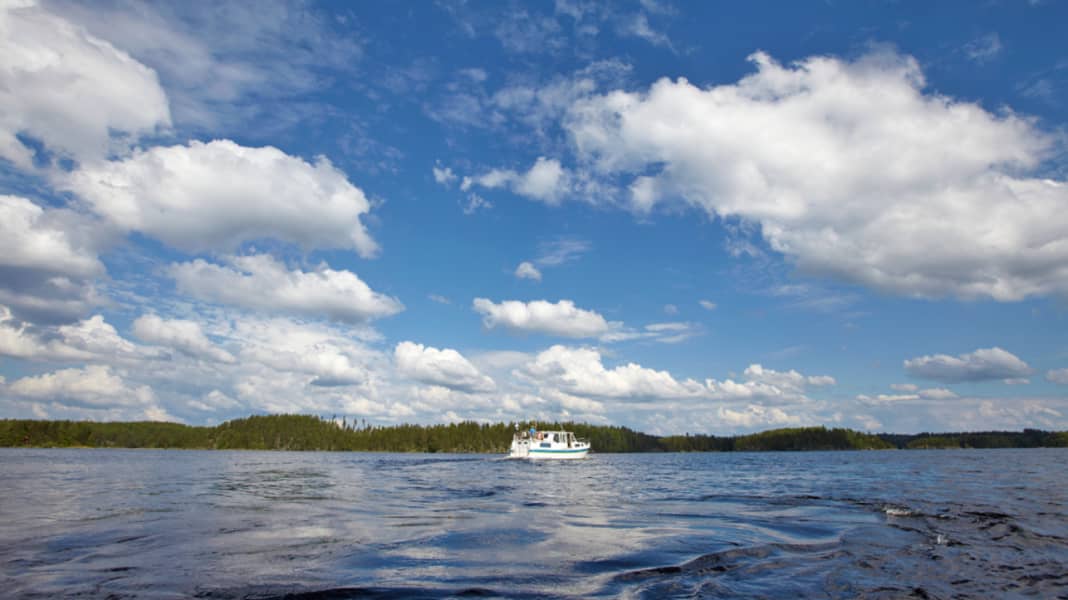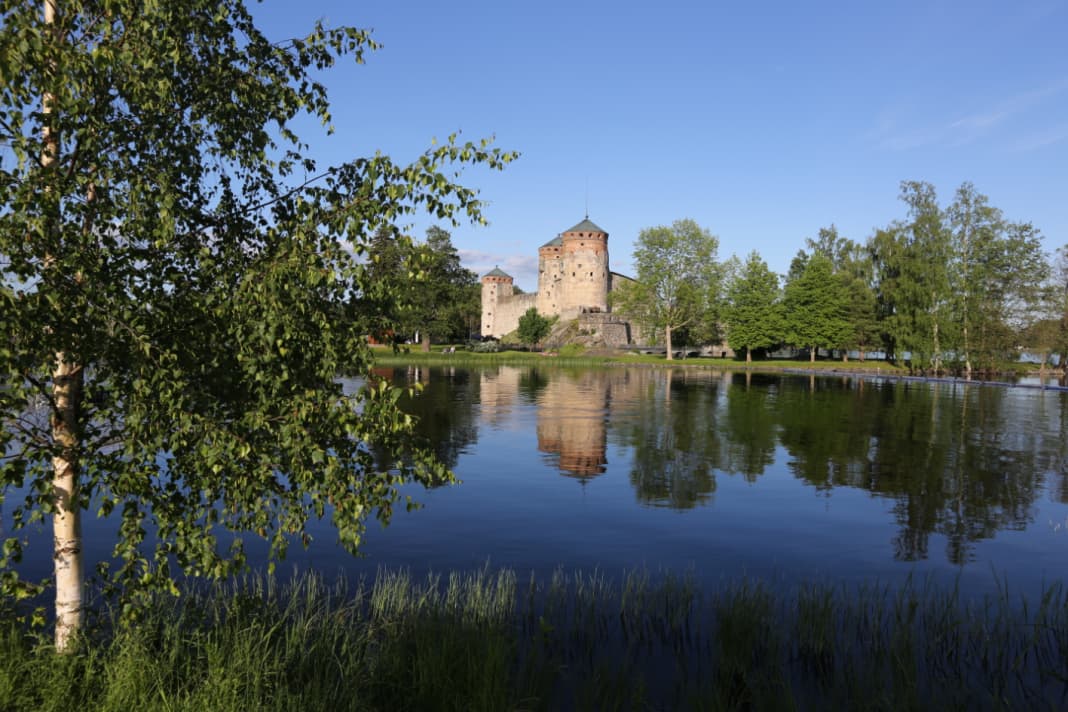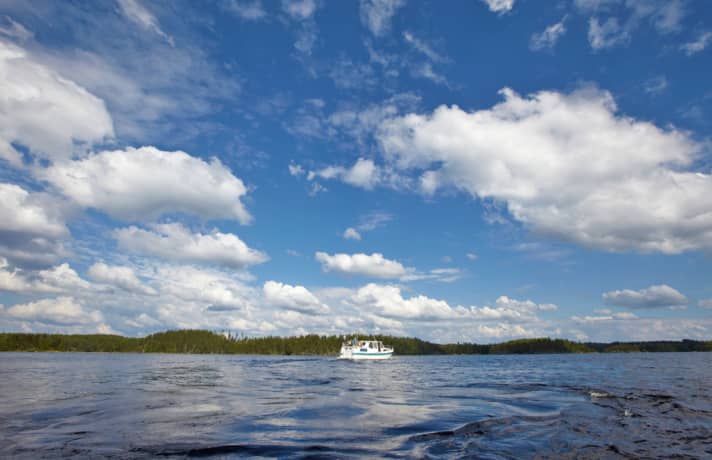







Clear lakes with quiet bays, dark forests of pine and birch, and a boundless sky above it all: the south of Finland is vastness and wilderness that you won't find anywhere else in Europe. Roads rarely cross this landscape, which is more water than anything else. There are only a handful of places worthy of the name along the shores - and if you include the islands, we are talking about 15,000 kilometres of coastline. That's roughly the distance between the Brandenburg Gate and Ayers Rock in the heart of Australia. It is therefore hardly surprising that the Saimaa lake system forms the largest navigable water network on our continent. Its surface area is eight times the size of Lake Constance - and forty times the size of the Müritz.

Those who board here are travelling in the truest sense of the word. Hours can pass without encountering another boat. And nowhere else can you simply drift for a while without worrying if you feel like it. In the evening, the logs crackle in the wood-burning stove of the sauna and sparks fly up into the bright Nordic sky. If you would like to jump from the stern into the water yourself - read on!
1 Linnansaari National Park
At the geographical centre of the lake district lies the island of Linnansaari, the centre of the national park of the same name. The park offers protection for many endangered species that were once widespread across southern Finland - such as the Saimaa ringed seal, of which only around 200 are thought to still exist. So much nature is naturally a marvellous nursery for mosquitoes. You either have to arm yourself against the buzzing pests or arrive before midsummer: The insects only appear in droves from the end of June. There are jetties with guest pitches in the south and north-east of the island.
2 Oravi
For anyone who has spent a night on Linnansaari, Oravi is real civilisation again - although the trading post on the old canal between Haukivesi and Joutenvesi has barely 100 inhabitants. The perfect place to enjoy a wonderfully cool beer on the veranda of the "Ravintola Ruukinranta". It's only a few steps from here to the boat at the guest harbour's floating dock ( www.saimaaholiday.net ).
3 Savonlinna
The city lies like a bar on three islands at the transition between the northern and southern parts of the Saimaa lake area. This strategic position was secured early on: Olavinlinna Castle, with its three defiant round towers, was built for this purpose and is now the symbol of Savonlinna. world-famous opera festival instead. Savonlinna is a great place to stock up on provisions, with everything you need - from disposable barbecues to insect repellent - available nearby at the guest harbour. Also worth seeing is the Regional and Maritime Museum. The base and jetty of our charter company Saimaan Solmu is located to the north, halfway to Oravi.
4 Kerimäki
The largest wooden church in the world stands in the middle of the forest in the south of Finland. The 27 metre high dome can accommodate up to 5000 people. However, it only gets really full during cultural events, such as guest concerts at the Savonlinna Opera Festival. It cannot be used in winter anyway - the fact that it is impossible to heat such a large wooden building was forgotten during planning. Guests can cater for themselves in the town, the harbour has no services whatsoever.
5 Punkaharju
Not far from this glacial ridge is the world-famous art museum "Retretti". The changing exhibitions are housed underground in tunnels and caverns that have been blasted out of the rock. An exciting contrast to the seemingly untouched nature on the surface. The museum is just a few minutes' walk from the nearby jetty.
6 Sulkava
The small town slumbers away in the shade of tall trees - a detour into typical Karelian style: houses and churches are made of wood and feature lots of beautiful carvings, which can be explored in a relaxed manner on a short walk. In the evening, we head to the sauna right by the harbour. Although it belongs to the small hotel next door, it is still open to guests - this is Finland after all!
7 Puumala
The modern elevated bridge can be recognised from afar, which is located at Puumala spans the fairway. From the small café at the top of its lift tower, you have a magnificent view of this bottleneck on land and at sea. The village's guest harbour lies at the foot of the bridge and is well protected from the swell of the wooden freighters on the sound by a long breakwater. Supermarket and restaurants next door.
8 Lappeenranta
The economic and tourist centre of southern Saimaa, a lively city of 70,000 inhabitants which offers guest crews a varied programme in summer: From concerts and other events, such as the sand sculpture festival, to the regional museum and the fortress on the hill just above the town harbour, where guests moor alongside the harbour wall and are within sight of the old town.
9 Imatra
After Lappeenranta, Imatra, with its 28,000 inhabitants, is the second largest industrial town on the southern shore of the Saimaa. It is named after a well-known waterfall on the river Vuoksi, one of the main tourist attractions in the region in summer (from mid-June). However, Imatra's large marina is located outside the town centre, around three kilometres away. What makes it an attractive stopover is the combination of a fully equipped marina (with bars for chilling out and barbecues for those with a bigger appetite, of course) and the extensive nature of the surrounding recreational area, which even includes a beach.
10 Saimaa Canal
The artificial connection to the Baltic Sea begins east of Lappeenranta and flows into the Gulf of Finland at Vyborg after almost 25 nautical miles (47 kilometres). Along the way, the waterway overcomes a gradient of 77 metres with eight barrages and crosses from Finland to Russia after almost a third of the route. However, an agreement between the two countries stipulates that the entire canal is supervised by the Finnish side. Transit for pleasure craft is possible without any problems after prior registration and is also free of charge. Information on the requirements and necessary documents can be found on the Finnish Transport Authority's website under the search term "Saimaa Canal", also in English: portal.liikennevirasto.fi
THE CHARTER COMPANY
The charter base Saimann Solmu is located around 15 kilometres north of Savonlinna and is therefore centrally located in the lake district. From there you can explore the north with Kuopio and Joensuu in the course of a week, as well as the south as far as Lappeenranta (you can find our suggested cruise for this on page 89).
The company offers steel boats from 8.50 metres to 12 metres in length. Contact: Saimaan Solmu, Jouko Soini (speaks German), Kupolantie 30, FIN-57310 Savonlinna, tel. ++358-400-97 62 27. www.saimaansolmu.fi
Our charter boat belonged to the Saima 1100 S type. The robust steel displacer (see photo on page 86) was 11.10 metres long and offered five fixed berths and one convertible berth. With the 120 hp diesel engine, we travelled at a comfortable 6.5 kn (about 12 km/h) on average. Two steering positions (inside and outside) make us independent of the weather. The equipment is functional, navigation material (except for a plotter) is fully available. The highlight, however, is the small on-board sauna in the stern! Weekly rates: 1400 to 2150 euros.
NAUTICAL INFORMATION
The precinct (named after its largest lake) covers an area of around 70,000 kilometres in the south of Finland, which is roughly the size of Bavaria. If you add up the water areas of the interconnected and navigable lakes, you still end up with around 4500 km. This makes the area the fourth largest lake in Europe. 14,000 islands are scattered across it, most of which are uninhabited.
The navigation is largely unproblematic thanks to a 3000 km long network of fully marked (and usually lighted) shipping lanes. However, as the unlicensed area is very extensive and the (tree-covered) shorelines look the same everywhere, determining your position requires constant vigilance. Good seamanship is therefore a must, especially if the skipper is less experienced.
Commercial shipping are only encountered - if at all - on the main shipping lanes. In addition to excursion boats, there are also freighters and, above all, tug and push boats that transport the region's most important raw material: Timber.
The harbours Although the infrastructure for pleasure craft is not complete, it is sufficient overall - which is no surprise for an area of this size. However, full service and catering facilities can be found in all the larger marinas.

